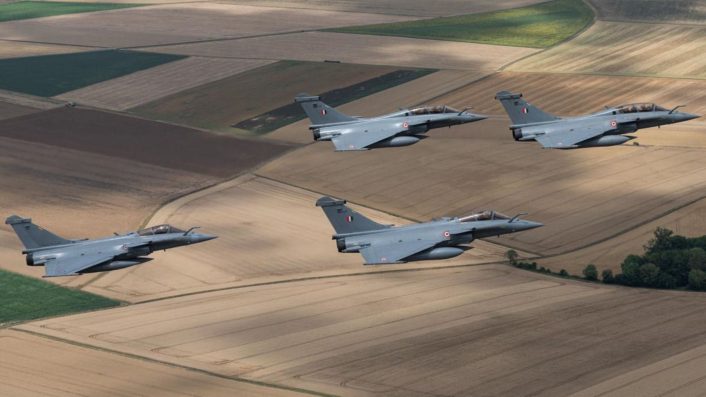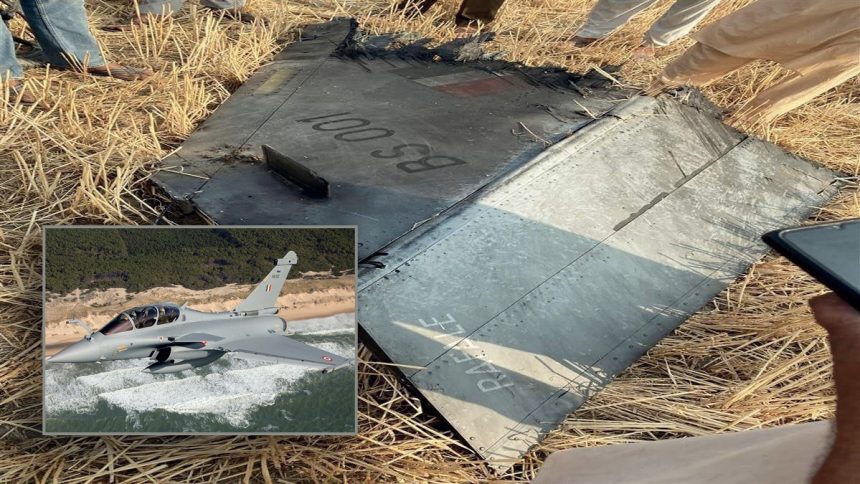After images of MICA air-to-air missiles and M88 engines, an image now clearly shows the vertical tail of a Rafale EH.
After much speculation about fighter jet losses, an image has now emerged online showing the vertical tail of an Indian Rafale EH allegedly shot down by Pakistan. As we mentioned in our previous report about the ongoing clashes between India and Pakistan, the latter claimed it shot down five aircraft of the former, including three Rafales.
The images
India has not confirmed the losses, although images emerged so far show the remains of an external fuel tank and a MICA air-to-air missile still attached to its launcher. The images were said to have been captured near the village of Aklian Kalan, Punjab, about 20 km from Bathinda air base, notably home of the Indian Rafales.
Likely looking at a loss of an Indian Air Force Mirage 2000 with a MICA (not sure what variant) AAM still in the rail https://t.co/D12STfxB5w
— Doha (@Doha104p3) May 7, 2025
Other images, said to have been captured in Bathinda, appear to show the wreck of a Snecma M88 engine, the same used by the Rafale. Some details, especially on the nozzle, strongly suggest that this could be indeed an M88 engine.
There’s a good chance that an Indian Rafale ate a PL-15 last night pic.twitter.com/fZU8j3bBKU
— Doha (@Doha104p3) May 7, 2025
Later, another image showed this time the vertical tail of a Rafale. Although it is cut halfway and it’s missing the tip, the markings and the Indian flag identify this part as belonging to the single-seat Rafale EH with serial BS 001 of the Indian Air Force.
CONFIRMED: One of the three Indian Rafale jets Pakistan claimed to have downed is now confirmed.
Wreckage bearing serial number BS-001 was found in Bathinda, verifying the Pakistani claim.
This was India’s first Dassault Rafale EH fighter jet. pic.twitter.com/xXrfhTtIUq
— Clash Report (@clashreport) May 7, 2025
While these clashes are generating lots of unverified or conflicting claims, and thus should be taken with a grain of salt, this image could be the definitive proof that a Rafale was indeed shot down.
For some quick reference, this would be the top of the tail section on the Rafale, below the RWR. the actual wording “Rafale” is on the rudder, and the registration is on the tail. Here’s a closer picture I got of the tail almost a year ago. BS = 1 seat, RB = 2 seat. https://t.co/oeRevOfHZK pic.twitter.com/OP232fuO9D
— TieDye Intel (@TieDyeIntel) May 7, 2025
Additionally, CNN reported that an unnamed high-ranking French intelligence official confirmed that a Rafale of the Indian Air Force was downed by Pakistan. Additionally, French authorities are looking into whether more than one Rafale jets were shot down by Pakistan, continues CNN.
New: A high-ranking French intelligence official told CNN that one Rafale fighter jet operated by the Indian Air Force was downed by Pakistan, in what would mark the first time that one of the sophisticated French-made warplanes has been lost in combat.
Pakistan claimed earlier… https://t.co/ixmULw1HXX
— Jim Sciutto (@jimsciutto) May 7, 2025
If confirmed, this would be the first combat loss of the French-made aircraft. Dassault and the French military have so far not responded to CNN‘s request for comments.
Meanwhile, Indian users on social media strongly reject the news and alleged confirmation of an Indian Air Force Rafale shot down by Pakistan.
Pro-Indian X users have been ceaselessly trying to manipulate X’s community notes to disseminate disinformation.
So far, they haven’t worked out.
Users can add context to posts to combat misinformation, but the system is vulnerable to coordinated manipulation by users with… pic.twitter.com/Kxpnljrqvn
— Clash Report (@clashreport) May 7, 2025
Others, based on a mistaken reverse image search suggested the photos of the Rafale tail were already online months ago. But it’s not the case and you can verify it yourself…
Another Google reverse image search banger. Check the Twitter or a reddit post or an article saying the date, don’t just take the date Google shows at first https://t.co/DhhoDYuYj4
— Doha (@Doha104p3) May 7, 2025
There’s a problem with google lens, it’s showing my recent post from September 25, 2024.
As my account is withheld in India so Indians are unable to verify the post.
Here’s a screen recording. https://t.co/fVBCwTEnKM pic.twitter.com/cfs54EmYEx
— Mohsin Ali (@Mohsin_o2) May 7, 2025
The causes
While it appears clear that the aircraft was a Rafale, what is still unclear is the cause of the crash. While some sources suggest that the aircraft might have been shot down by Chinese-made HQ-9 long-range semi-active radar homing (SARH) surface-to-air missile (SAM), photographic evidence suggest that the weapon involved could be the PL-15E active radar-guided (ARH) long-range air-to-air missile.
Debris of the PL-15E were photographed in the northeast of the Indian state of Punjab, the same state where Bathinda air base is located. A first photo, which has been circulating online since earlier in the day, shows a section of the missile, identified to be from immediately behind the radome.
CONFIRMED: Pakistan used Chinese long-range air-to-air missile PL-15E against India.
Parts of the missile fell in Hoshiarpur, Punjab, India. Photo (1st and 2nd) provided by Indian media.
The PL-15 has a range of 200-300 km for the domestic version and about 145 km for the… pic.twitter.com/51YXEuFrAv
— Clash Report (@clashreport) May 7, 2025
Another image appears to show the active electronically scanned array (AESA) seeker of the PL-15E. Although the location is not specified, the component is said to have been found deep into Indian territory.
Didn’t think I’d ever see a PL-15(E)’s AESA without going to a vault lol
Good to know my guess was right pic.twitter.com/XQBwDiMOoN
— John Ridge 🇺🇸 🇺🇦 🇹🇼 (@John_A_Ridge) May 7, 2025
Indian Rafales
The Indian Air Force received its first Rafales in July 2020, part of a contract for 36 aircraft signed in 2016. The contract was the result of the Medium Multi-Role Combat Aircraft (MMRCA) program, which dates back to 2004.
Initially India was planning to receive 126 aircraft, with a large part manufactured locally. The Rafale was shortlisted together with the Eurofighter Typhoon in 2011, and was declared as the winner the following year. The program later changed and the contract was signed for only 36 aircraft.

The aircraft were designated as Rafale EH (single seat) and Rafale DH (twin seat). In fact, the aircraft were modified based on Indian requirements. Starting from baseline F3-R-standard aircraft, they received as many as 14 different Indian-specific modifications.
According to available info, among the modifications, the Indian Rafales include an improved version of the Thales Front Sector Optronics (FSO) system, the DASH Helmet Mounted Display, modified radar altimeter, and modified RBE2 radar’s software. Regarding the weapons, the Indian Rafales came with MICA and Meteor air-to-air missiles, as well as SCALP-EG air launched cruise missiles.
If it’s true the #PakistanAirForce shot down #IndianAirForce Rafales – and there is video evidence of a Rafale M88 engine in a field in India, #Dassault must be shocked. We were always told Rafale’s #Spectra EW system was best in the world. The J-10C/PL-15 combo is deadly.
— Alan Warnes (@warnesyworld) May 7, 2025
J-10CE and PL-15E
Pakistani sources claimed that the Rafale was shot down by a Chinese-made J-10CE with a PL-15E missile. Should this be confirmed, this would be the first combat win of both the aircraft and the weapon.
Pakistan’s Prime Minister claims that five fighter jets operated by the Indian Air Force were downed during last night’s missile attack and resulting escalation, with all of the aircraft claimed to have been shot down by Pakistani J-10Cs using PL-15 Air-to-Air Missiles.
— OSINTdefender (@sentdefender) May 7, 2025
The delta-wing J-10 flew for the first time in 1998, with almost 500 built so far for the People’s Liberation Army Air Force. Given its appearance, many believe that the aircraft developed from the Israeli IAI Lavi, with various sources claiming that they had confirmation about the connection between the two aircraft and other denying everything. However, no formal statements have ever been disclosed to address this controversy.
The Lavi, which was designed as a strike fighter aircraft in the same class of the F-16 Fighting Falcon, was planned to become the main fighter aircraft of the Israeli Air Force, however the program was cancelled in 1987, a year after its first flight, due to economic controversy. Much like the J-10, the Lavi had a delta wing design with canards and an air inlet with splitter plate under the fuselage, just below the cockpit.
The J-10 has been upgraded through the years, with the J-10C variant now featuring AESA radar, IRST (Infrared Search and Track) sensor, advanced ECM (Electronic Counter Measures) and an indigenous WS-10 engine to replace the Russian AL-31FN engine used by earlier variants. As for the armament, the J-10C is equipped with PL-10 and PL-15 air-to-air missiles as well as various types of smart air-to-ground weapons. Many of these weapons are also shared by the JF-17, which is employed by Pakistan.
A #Pakistan Air Force J-10C fighter aircraft in full air-to-air combat loadout conducting aerial warfare operations during ongoing PAF full-scale exercises, held in all three regional theatre commands this week, late April 2025: pic.twitter.com/qFxYvtwvbS
— The STRATCOM Bureau (@OSPSF) April 29, 2025
The J-10, also known as Vigorous Dragon, was first offered to Pakistan in 2006, but the negotiations were stalled as the government decided to concentrate resources on the indigenous JF-17 Thunder. In late 2020 it was revealed that Pakistan was still interested in the J-10, and specifically the export variant of the J-10C, called J-10CE.
The acquisition was framed as a response to the Indian acquisition of the Rafale. The first J-10CEs were delivered in March 2022. The aircraft were also reportedly employed to strike militant targets in Iran in 2024.
Notably, just as tension kept arising in the last few days, Pakistan showed J-10s and JF-17s armed with PL-15E missiles.
The PL-15 is China’s standard ARH air-to-air missile, intended to match the U.S.-made AIM-120D AMRAAM (Advanced Medium-Range Air-to-Air Missile). The missile was designed to fit inside the weapon bays of the J-20 stealth fighter.
The export variant has a reported range of 90 miles, instead of the 124 of the domestic variant. The latter is said to be propelled by a dual-pulse rocket motor. The PL-15E has an AESA seeker and a two-way datalink that allows the launching aircraft to exchange information with the weapon.









